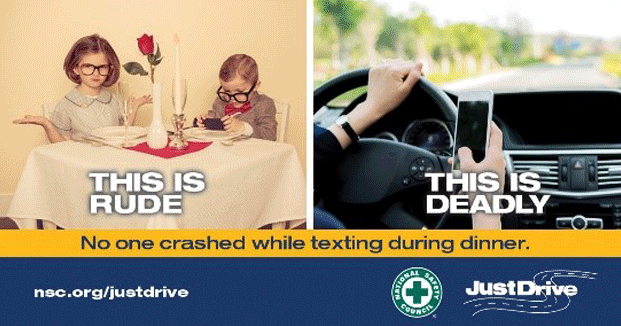By Brian Ayers
Everyone has seen a driver distracted by a cell phone, but when you are the one distracted, you often don’t realize that driver is you.
Although there are many things that contribute to distracted driving, the National Safety Council reports that cell phone use occurs with such frequency and duration that it is more likely to lead to a crash, or near-crash event, than any other form of distraction.
New technology in vehicles is causing us to become more distracted behind the wheel than ever before. Fifty-three percent of drivers believe that if manufacturers put “infotainment” dashboards and hands-free technology for cell phones in vehicles, they must be safe. With some state laws focusing solely on handheld bans, many drivers honestly believe they are making the safe choice by using a hands-free device. But in fact, even these technologies distract our brains long after we’ve used them.
Make no mistake: This multitasking technology is about convenience, not safety.
Here are seven steps we all can take right now to reduce our distraction while driving:
Avoid Temptation
Don’t talk or text on your phone. Turn it off while driving or place your device in the glove box or center console so it’s out of sight and out of mind.

Vary Your Route
When possible, take a different route so routine trips like commuting to and from work don’t become mundane.
Keep Your Eyes Moving
Make a full mirror sweep with your eyes every 5-6 seconds to stay alert and ward off allowing your mind to wander.
Keep a Safe Following Distance
Driver training experts suggest a following distance of 3-4 seconds in good weather – more in inclement weather. The 3-4 second following rule increases visibility and gives more time to react to what’s happening in front of you, reducing risk to you and your passengers.
Clear Your Mind
You cannot focus on driving if your mind is on work or family pressure or your to-do lists. Take a moment before you drive to get your mind focused on the task at hand – getting to your destination safely.
Have a Plan
Don’t wait until you are driving to plan and become familiar with your route. Use navigation devices with voice directions and set them prior to leaving.
Help Others Help Themselves
Make it a practice when you call someone’s cell phone to ask if they are driving. If the answer is “yes”, take it upon yourself to call back later or ask them to return your call when they have reached their destination. Never text someone you know to be driving.
Use your car’s safety devices safely
Have you heard about or seen all the new safety devices and features that are being installed in many vehicles today? The level of semiautonomous technology in new cars is impressive. Adaptive cruise control ensures your car slows with traffic. Lane departure warning technology tells you when you’ve strayed over the line. Some cars will tell you when you’re nodding off, while others will actually stop your car if a pedestrian steps into your path.
Health and safety programs at Xerox
Health and safety is a value demonstrated through programs, emergency preparedness and maintaining strict standards.
Environment, health, safety and sustainability at Xerox: Learn how we align our goals for the environment, health and safety in five key areas to make an impact across our value chain worldwide.
These systems, in practice if not by design, allow drivers to pay less attention to the road ahead. But that may also be the big problem with semiautonomous vehicles; the “semi” in semiautonomous means the technology still requires human interaction. We may come to count on our cars to keep us out of trouble, even in situations where the technology isn’t designed to.
Semiautonomous vehicles work best with drivers who trust the technology and are adequately trained how and when to use it. As more people purchase vehicles with this new technology, more training and education will be needed to ensure drivers know how to use them safely. Auto dealerships should spend more time working with customers to fully explain the limits of automotive safety technology before letting them drive home.
Time will tell how much safer driving will be with the new semiautonomous technology. But one thing is for sure, there is no turning back now. This new technology is not going away, and it likely will be doing more in the years to come.
More information about distracted driving
- Eyes on the Road – A Minute of Health with CDC [PODCAST 0:59 seconds]
- Eyes on the Road – A Cup of Health with CDC [PODCAST 04:43 minutes]
- Distracted Driving – What you need to know about distracted driving from the Centers for Disease Control and Prevention
- Morbidity and Mortality Weekly Report : Mobile Device Use While Driving Weekly Report- – United States and Seven European Countries, 2011
- World Health Organization ─ Mobile Phone Use: A Growing Problem of Driver Distraction
- The Guardian — Who’s driving? Autonomous Cars may be entering the most dangerous phase





Texting is not just a “teen” problem. There are millions of employees in company cars and fleet vehicles who try to “multi-task” behind the wheel.
While many states seek to lower distracted driving by increasing penalties, fees and regulations, there is another option. There are anti-texting apps, like AT&T DriveMode which is FREE!
One area that is rarely discussed is that each state has thousands of government vehicles that inspectors, regulators and the agricultural department use as fleet vehicles, but they do not have the technology to diminish distracted driving. I would love to see one state lead by example and use a program, like FleetMode.com, to block texts, redirect incoming phone calls, and impede all other apps in the State vehicles. If we want our state roads to be safer, let’s start by making our state vehicles safer.